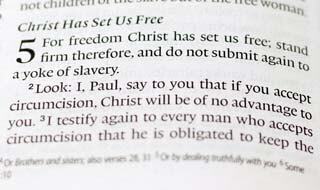“And without controversy, great is the mystery of godliness: God was manifest in the flesh, justified in the Spirit, seen of angels, preached unto the Gentiles, believed on in the world, received up into glory” (I Timothy 3:16).
According to the third-century historian Eusebius, it was customary among early Christians to express their faith in credal hymns. It is generally thought that in the latter part of the text cited above, the Apostle Paul employed such a hymn to emphasize the dignity of the Person of the Lord Jesus Christ: “GOD WAS manifested in the flesh, vindicated by the Spirit; seen by angels, preached among the nations; believed on in the world, taken up into glory.”
These few lines, in their implication of Christ’s pre-existence and assertion of His incarnation, summarize the earthly work of the Son of God.
1. God was manifested in the flesh.
This is what Christmas is all about. “When the fullness of the time was come, God sent forth His Son, made of a woman” (Galatians 4:4).[1]
It is because the Babe of Bethlehem was God manifest in the flesh that the heavenly host of the Judean hills praised God, saying, “Glory to God in the highest, and on earth peace, good will toward men” (Luke 2:14).
2. Christ was vindicated by the Spirit.
The angels of God were well aware of the glory of Him who was from eternity, but, like the prophets of old. they were puzzled about His suffering (I Peter 1:10-12). Why should the eternal Son come to earth as a servant?
Why did not all mankind worship at His feet? Surely the Creator, the God of all eternity, must be extolled by His creatures! How could they nail Him to a cross? Then came His vindication. By the power of the Holy Spirit He was raised from the dead and declared to be the Son of God (Romans 1:4; I Peter 3:18).
3. He was seen by angels.
A better translation would be, “He showed Himself to angels.” The allusion seems to indicate more than the fact that there were angels at the empty tomb on the first Easter [Matthew 28:5; John 20:11-17]. Probably the reference is to the majestic occasion when after His resurrection, He presented Himself to the Father and all the holy angels in heaven [Revelation 5:11-12].
4. He was preached among the nations.
Beginning with the age of the apostles, the Gospel has been proclaimed far and wide, “that Christ died for our sins according to the Scriptures, and that he was buried, and that he rose again the third day according to the Scriptures” (I Corinthians 15:3-4).
The good news is not simply that a Child was born, but that a Son was given to redeem mankind (Isaiah 9:6; Ephesians 1:7; Hebrews 9:12).
5. He was believed on in the world.
Although many of the Lord’s own people rejected Him, as have myriads of men and women throughout the centuries, other multitudes have believed on Him as the Son of God and their personal Saviour, and by this faith have entered into eternal life (John 3:16).
6. He was taken up into glory.
The risen, living Christ ascended in triumph and glory into heaven, the place of glory. Now He is seated at the Father’s right hand. Evermore He will be admired and exalted because of who He is and what He accomplished on earth. “Worthy is the Lamb that was slain to receive power, and riches, and wisdom, and strength, and honor, and glory, and blessing” (Revelation 5:12).
Once each year, Christendom celebrates the birth of the Saviour. It must grieve the Godhead—the Father, the Son, and the Holy Spirit—that a sacred occasion which ought to be commemorated in awe and with joy, is almost completely stained with tinsel and blasphemy. Not all, however, forget or neglect the Person of Christ. There is a remnant who confess His name. “Whosoever therefore shall confess me before men,” He said, “him will I confess also before Father who is in heaven” (Matthew 10:32).
This is Christ’s message this Christmas.
from: The Pilgrim, in Triumphs of Faith. Osterhus Publishing House, 4500 W Broadway. Minneapolis. MN 55422 Toll Free 1-877-643-4229 http://www.osterhuspub.com
[1] Some recent translations read “He” appeared, or “Who” appeared… Some older Greek manuscripts do have this reading in Greek (“Os”), but the majority–and the traditionally received text–read “God” was manifested (appeared) …” The Greek letter “O” (omicron) looks very similar to the Greek letter “theta” which is the first letter in “Theos,” meaning “God.” (See John 1:1,2,14) – JBW

















